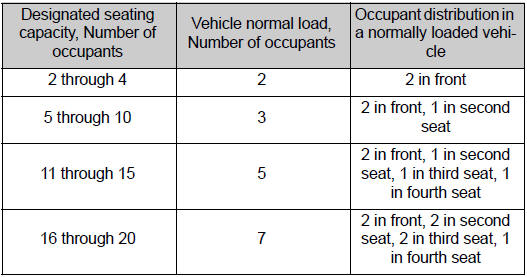Toyota Camry: Specifications
 Toyota Camry: Specifications
Toyota Camry: Specifications
Maintenance data (fuel, oil level, etc.)
Dimensions and weights
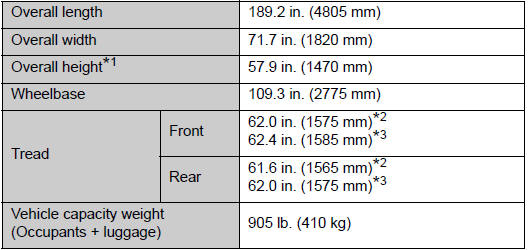
*1: Unladen vehicles
*2: P215/55R17 and P225/45R18 tires
*3: P205/65R16 tires
Vehicle identification
■ Vehicle identification number
The vehicle identification number (VIN) is the legal identifier for your vehicle. This is the primary identification number for your Toyota. It is used in registering the ownership of your vehicle.
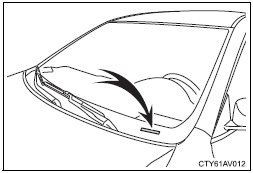
This number is located on the top left of the instrument panel.
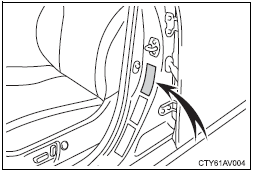
This number is also on the Certification Label.
■ Engine number
The engine number is stamped on the engine block as shown.
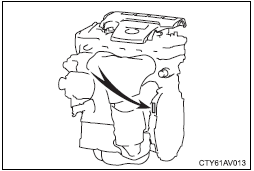
2.5 L 4-cylinder (2AR-FE) engine
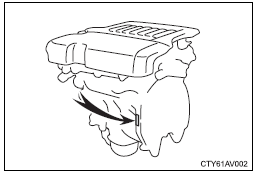
3.5 L V6 (2GR-FE) engine
Engine
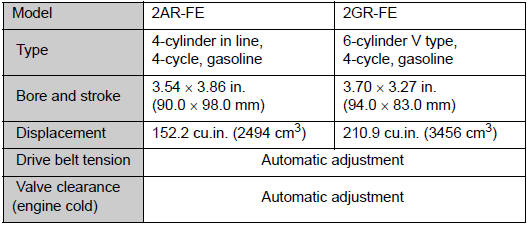
NOTICE
■Drive belt type (2.5 L 4-cylinder [2AR-FE] engine only)
The high strength drive belt is used for the generator side drive belt.
When replacing the drive belt, use Toyota genuine drive belt or equivalent
high strength drive belt. If the high strength drive belt is not used,
durability
of the belt may become less than expected. The high strength drive belt is a
belt with Aramid core which has higher strength compared to usually available
belts with PET or PEN core.
Fuel

Lubrication system
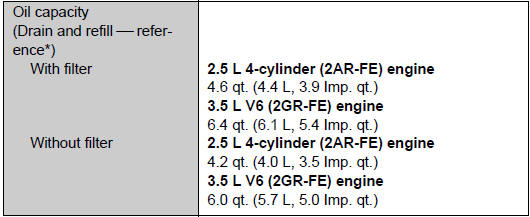
*: The engine oil capacity is a reference quantity to be used when changing the engine oil. Warm up and turn off the engine, wait more than 5 minutes, and check the oil level on the dipstick.
Engine oil selection
“Toyota Genuine Motor Oil” is used in your Toyota vehicle. Use Toyota approved “Toyota Genuine Motor Oil” or equivalent to satisfy the following grade and viscosity.
Oil grade: ILSAC multigrade engine oil
Recommended viscosity: SAE 0W-20
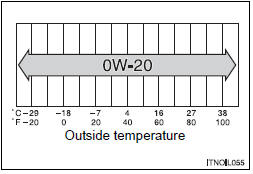
SAE 0W-20 is the best choice for good fuel economy and good starting in cold weather.
If SAE 0W-20 is not available, SAE 5W-20 oil may be used.
However, it must be replaced with SAE 0W-20 at the next oil change.
Oil viscosity (0W-20 is explained here as an example):
• The 0W in 0W-20 indicates the characteristic of the oil which allows cold startability. Oils with a lower value before the W allow for easier starting of the engine in cold weather.
• The 20 in 0W-20 indicates the viscosity characteristic of the oil when the oil is at high temperature. An oil with a higher viscosity (one with a higher value) may be better suited if the vehicle is operated at high speeds, or under extreme load conditions.
How to read oil container label:
The ILSAC (International Lubricant Standardization and Approval Committee) Certification Mark is added to some oil containers to help you select the oil you should use.
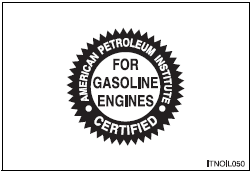
Cooling system
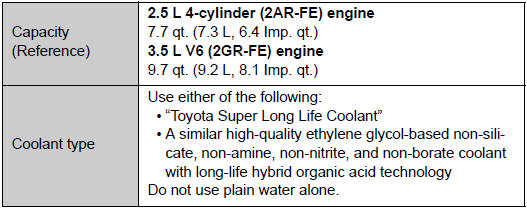
Ignition system

NOTICE
■Iridium-tipped spark plugs
Use only iridium-tipped spark plugs. Do not adjust the spark plug gap.
Electrical system

Automatic transaxle

*: The fluid capacity is a reference quantity. If replacement is necessary, contact your Toyota dealer.
NOTICE
■Transmission fluid type
Using transmission fluid other than “Toyota Genuine ATF WS” may cause
deterioration in shift quality, locking up of the transmission accompanied by
vibration and, ultimately, damage to the vehicle’s transmission.
Brakes
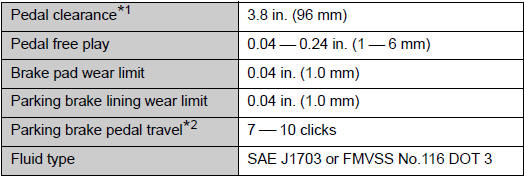
*1: Minimum pedal clearance when depressed with a force of 112 lbf (500 N,
51 kgf) while the engine is running
*2: Parking brake pedal travel when depressed with a force of 67 lbf (300 N, 31
kgf).
Steering

Tires and wheels
16-inch tires
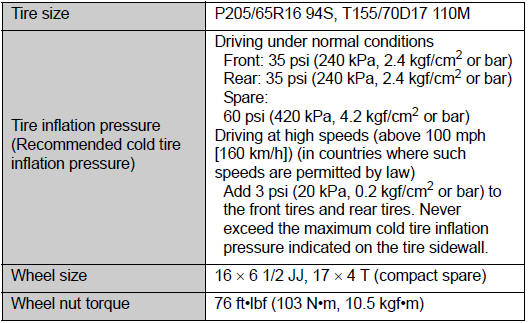
17-inch tires
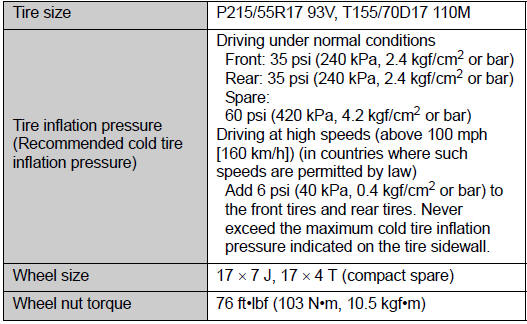
18-inch tires
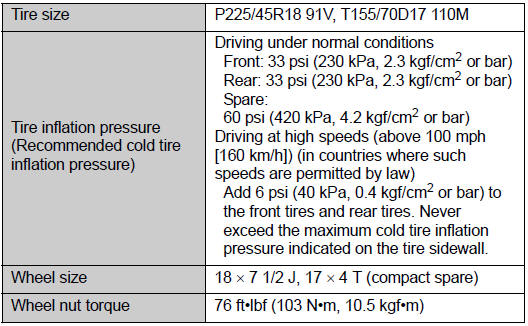
Light bulbs
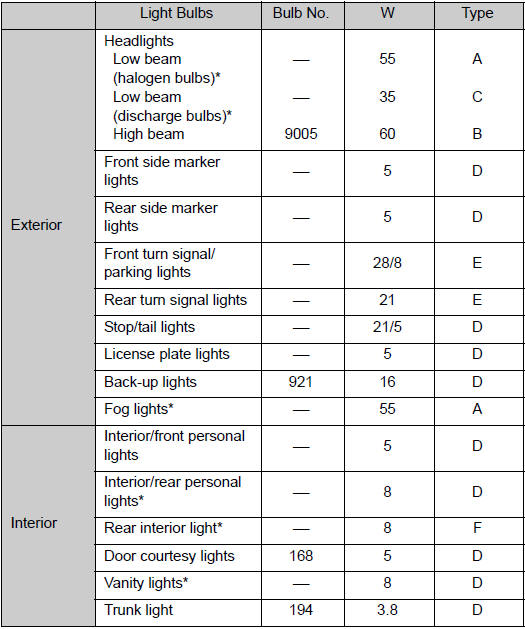
*: If equipped
A: H11 halogen bulbs
B: HB3 halogen bulbs
C: D4S discharge bulbs
D: Wedge base bulbs (clear)
E: Wedge base bulbs (amber)
F: Double end bulbs
Fuel information
You must only use unleaded gasoline in your vehicle.
Select octane rating 87 (Research Octane Number 91) or higher. Use of unleaded gasoline with an octane rating lower than 87 may result in engine knocking. Persistent knocking can lead to engine damage.
At minimum, the gasoline you use should meet the specifications of ASTM D4814 in the U.S.A. and CGSB3.5-M93 in Canada.
Fuel tank opening for unleaded gasoline
To help prevent incorrect fueling, your vehicle has a fuel tank opening that only accommodates the special nozzle on unleaded fuel pumps.
Gasoline quality
In very few cases, driveability problems may be caused by the brand of gasoline you are using. If driveability problems persist, try changing the brand of gasoline. If this does not correct the problem, consult your Toyota dealer.
Gasoline quality standards
●Automotive manufacturers in the U.S.A., Europe and Japan have developed a specification for fuel quality called the World-Wide Fuel Charter (WWFC), which is expected to be applied worldwide.
●The WWFC consists of four categories that are based on required emission levels. In the U.S., category 4 has been adopted.
●The WWFC improves air quality by lowering emissions in vehicle fleets, and improves customer satisfaction through better performance.
Recommendation of the use of gasoline containing detergent additives
●Toyota recommends the use of gasoline that contains detergent additives to avoid the build-up of engine deposits.
●All gasoline sold in the U.S.A. contains detergent additives to clean and/ or keep clean intake systems.
Recommendation of the use of cleaner burning gasoline
Cleaner burning gasoline, including reformulated gasoline that contains oxygenates such as ethanol or MTBE (Methyl Tertiary Butyl Ether) is available in many areas.
Toyota recommends the use of cleaner burning gasoline and appropriately blended reformulated gasoline. These types of gasoline provide excellent vehicle performance, reduce vehicle emissions and improve air quality.
Non-recommendation of the use of blended gasoline
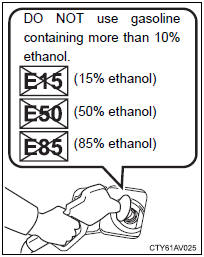
●Use only gasoline containing a maximum of 10% ethanol.
DO NOT use any flex-fuel or gasoline that could contain more than 10% ethanol, including from any pump labeled E15, E30, E50, E85 (which are only some examples of fuel containing more than 10% ethanol).
●If you use gasohol in your vehicle, be sure that it has an octane rating no lower than 87.
●Toyota does not recommend the use of gasoline containing methanol.
Non-recommendation of the use of gasoline containing MMT
Some gasoline contains an octane enhancing additive called MMT (Methylcyclopentadienyl Manganese Tricarbonyl).
Toyota does not recommend the use of gasoline that contains MMT. If fuel containing MMT is used, your emission control system may be adversely affected.
The malfunction indicator lamp on the instrument cluster may come on. If this happens, contact your Toyota dealer for service.
If your engine knocks
●Consult your Toyota dealer.
●You may occasionally notice light knocking for a short time while accelerating or driving uphill. This is normal and there is no need for concern.
NOTICE
■Notice on fuel quality
●Do not use improper fuels. If improper fuels are used, the engine will be
damaged.
●Do not use leaded gasoline.
Leaded gasoline can cause damage to your vehicle’s three-way catalytic
converters causing the emission control system to malfunction.
●Do not use gasohol other than the type previously stated.
Other gasohol may cause fuel system damage or vehicle performance
problems.
●Using unleaded gasoline with an octane number or rating lower than the
level previously stated will cause persistent heavy knocking.
At worst, this will lead to engine damage.
■Fuel-related poor driveability
If poor driveability is encountered after using a different type of fuel (poor
hot
starting, vaporization, engine knocking, etc.), discontinue the use of that type
of fuel.
■When refueling with gasohol
Take care not to spill gasohol. It can damage your vehicle's paint.
Tire information
Typical tire symbols
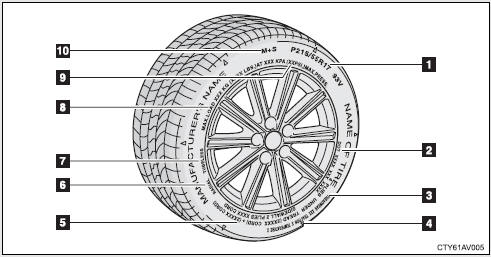
Full-size tire
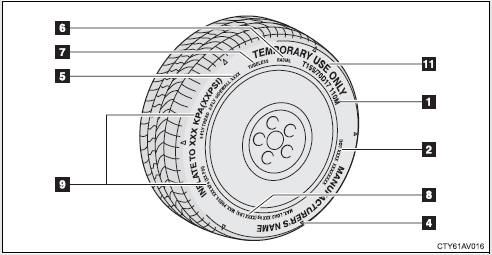
Compact spare tire
- Tire size
- DOT and Tire Identification Number (TIN)
- Uniform tire quality grading
For details, see “Uniform Tire Quality Grading” that follows. - Location of treadwear indicators
- Tire ply composition and materials
Plies are layers of rubber-coated parallel cords. Cords are the strands which form the plies in a tire. - Radial tires or bias-ply tires
A radial tire has “RADIAL” on the sidewall. A tire not marked “RADIAL” is a bias-ply tire. - TUBELESS or TUBE TYPE
A tubeless tire does not have a tube and air is directly put into the tire. A tube type tire has a tube inside the tire and the tube maintains the air pressure. - Load limit at maximum cold tire inflation pressure
- Maximum cold tire inflation pressure
This means the pressure to which a tire may be inflated. - Summer tires or all season tires
An all season tire has “M+S” on the sidewall. A tire not marked “M+S” is a summer tire. - “TEMPORARY USE ONLY”
A compact spare tire is identified by the phrase “TEMPORARY USE ONLY” molded on its sidewall. This tire is designed for temporary emergency use only.
Typical DOT and Tire Identification Number (TIN)
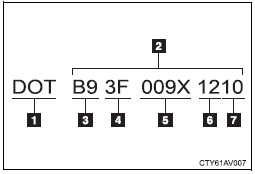
- DOT symbol*
- Tire Identification Number (TIN)
- Tire manufacturer's identification mark
- Tire size code
- Manufacturer's optional tire type code (3 or 4 letters)
- Manufacturing week
- Manufacturing year
*: The DOT symbol certifies that the tire conforms to applicable Federal Motor Vehicle Safety Standards.
Tire size
■ Typical tire size information
The illustration indicates typical tire size.
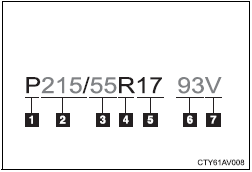
- Tire use
(P = Passenger car,
T = Temporary use) - Section width (millimeters)
- Aspect ratio
(tire height to section width) - Tire construction code
(R = Radial, D = Diagonal) - Wheel diameter (inches)
- Load index (2 digits or 3 digits)
- Speed symbol
(alphabet with one letter)
■ Tire dimensions
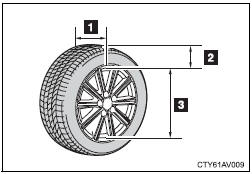
- Section width
- Tire height
- Wheel diameter
Tire section names
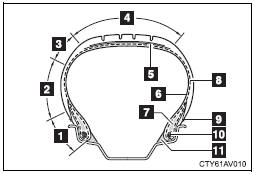
- Bead
- Sidewall
- Shoulder
- Tread
- Belt
- Inner liner
- Reinforcing rubber
- Carcass
- Rim lines
- Bead wires
- Chafer
Uniform Tire Quality Grading
This information has been prepared in accordance with regulations issued by the National Highway Traffic Safety Administration of the U.S. Department of Transportation.
It provides the purchasers and/or prospective purchasers of Toyota vehicles with information on uniform tire quality grading.
Your Toyota dealer will help answer any questions you may have as you read this information.
■ DOT quality grades
All passenger vehicle tires must conform to Federal Safety Requirements in addition to these grades. Quality grades can be found where applicable on the tire sidewall between tread shoulder and maximum section width.
For example: Treadwear 200 Traction AA Temperature A
■ Treadwear
The treadwear grade is a comparative rating based on the wear rate of the tire when tested under controlled conditions on a specified government test course.
For example, a tire graded 150 would wear one and a half (1 - 1/2) times as well on the government course as a tire graded 100.
The relative performance of tires depends upon the actual conditions of their use. Performance may differ significantly from the norm due to variations in driving habits, service practices and differences in road characteristics and climate.
■ Traction AA, A, B, C
The traction grades, from highest to lowest, are AA, A, B and C, and they represent the tire's ability to stop on wet pavement as measured under controlled conditions on specified government test surfaces of asphalt and concrete.
A tire marked C may have poor traction performance.
Warning: The traction grade assigned to this tire is based on braking (straight ahead) traction tests and does not include cornering (turning) traction.
■ Temperature A, B, C
The temperature grades are A (the highest), B, and C, representing the tire's resistance to the generation of heat and its ability to dissipate heat when tested under controlled conditions on a specified indoor laboratory test wheel.
Sustained high temperature can cause the material of the tire to degenerate and reduce tire life, and excessive temperature can lead to sudden tire failure.
Grade C corresponds to a level of performance which all passenger car tires must meet under the Federal Motor Vehicle Safety Standard No. 109.
Grades B and A represent higher levels of performance on the laboratory test wheel than the minimum required by law.
Warning: The temperature grades of a tire assume that it is properly inflated and not overloaded.
Excessive speed, underinflation, or excessive loading, either separately or in combination, can cause heat buildup and possible tire failure.
Glossary of tire terminology
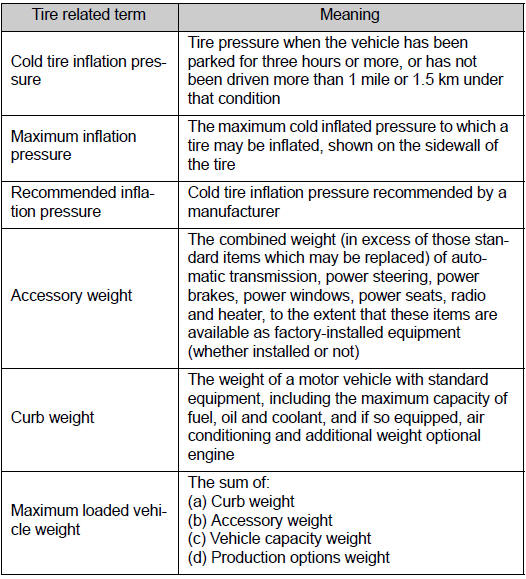
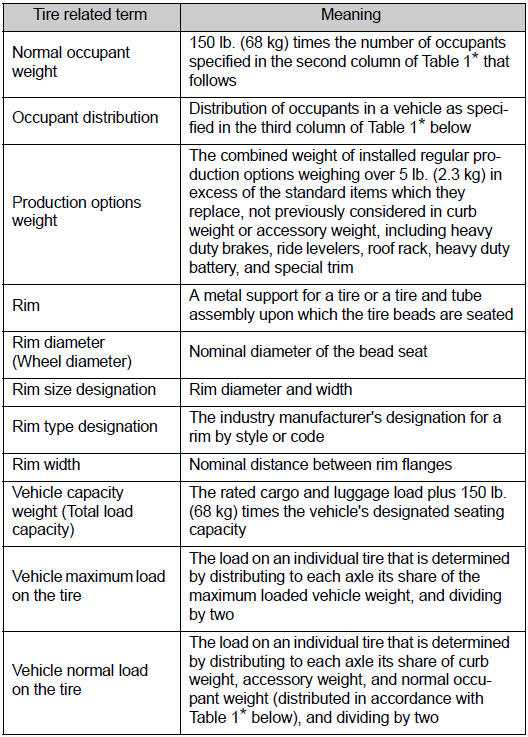
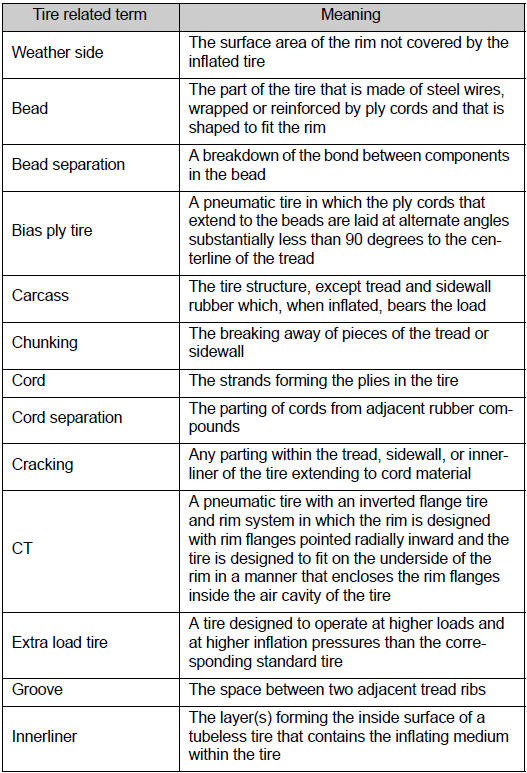
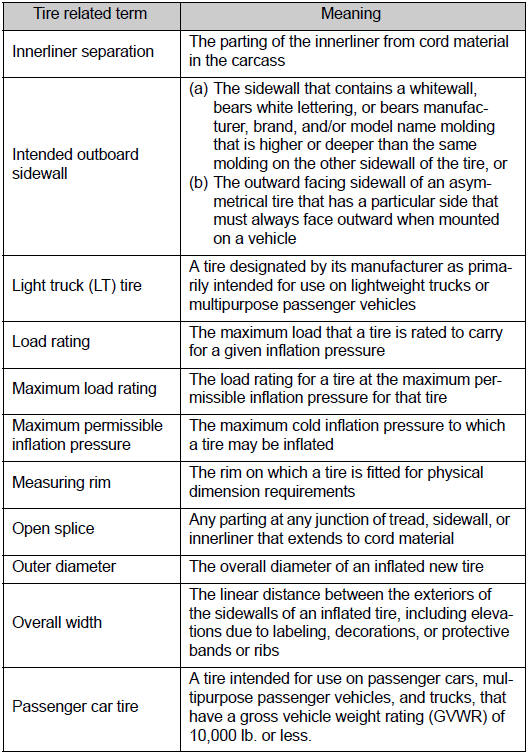

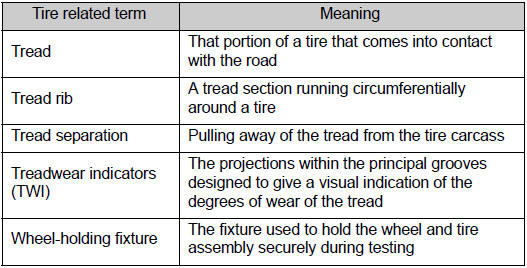
*: Table 1 ⎯ Occupant loading and distribution for vehicle normal load for various designated seating capacities
